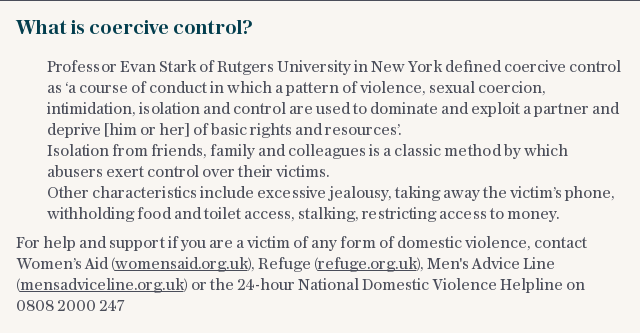When she threatened to leave, he threatened to kill himself: the story behind a landmark coercive control case

When Ami first met Steven Saunders through mutual friends, she was struck by how attentive he was: often quick to compliment her, he made her feel special. He even wrote her a long letter in which he sang her praises. Compared to her previous boyfriends, he seemed like a breath of fresh air, and she fell for him hard.
Barely a few weeks into their relationship, however, things began to change. Saunders, 31, told her he had no bank account and therefore needed to use hers. He would borrow her card to withdraw “his” cash but withdraw hers as well. When she grew suspicious of his actions, he denied it all, telling her he’d won the cash at the betting shop. He also sold her mobile phone, which enabled him to control whom she spoke to.
Other behaviour of his was meanwhile starting to trouble her, especially when he had been drinking. He'd make various threats to harm himself, emotionally blackmailing her into doing what he wanted.
Walking away would seem like the obvious response to a relationship that had taken such a worrying turn; but things were not that simple. Ami, also in her early 30s, had quickly fallen pregnant to Saunders. The couple, from Surrey, did not have a place to live together, but Ami could have gone to stay with her mother. Yet Saunders would not countenance it, and each time Ami indicated she was going to leave him, he would threaten to kill himself, and did indeed self-harm in front of her. She wanted them to find somewhere they could live together, but he forced her to sleep on the streets and to beg. At other times, they slept in cars and car parks.
Emotional blackmail in such relationships is not uncommon. This week, Connor Appleyard was jailed for 16 months at Hull Crown Court for his coercive behaviour after making his then-girlfriend Kate Gutteridge, 33, his personal slave. Appleyard, who also made the mother-of-one taste every meal before he ate beforehand "to check they weren't laced with poison", threatened he would kill himself in front of her 13-year-old son if she ever left him.
Victims, then, can effectively find themselves trapped. Ami's loving and supportive family were anxious that she leave Saunders, but whenever she spoke to them on the phone, Saunders would be standing there next to her, limiting her ability to communicate freely.
In what is a believed to be a landmark case, Saunders was convicted of coercive and controlling behaviour towards Ami and in February was jailed for 18 months. “This was by far one of the most extreme controlling behaviour cases I have come across,” says Rachel Fattore, a social worker who was involved in the case because it involved an unborn child. “He would frequently tell lies and she just couldn’t tell what was real and what wasn’t in the end because he was so convincing.”

Known as gaslighting, this kind of psychological manipulation is often seen in cases of coercive control. But until recently, there was no specific law against such behaviours. The relatively new offence of controlling or coercive behaviour in an intimate or family relationship was created in the Serious Crime Act 2015 and covers a range of actions, including isolating a person from their friends and family; monitoring their time; taking control over aspects of their everyday life, such as where they can go, who they can see, what they can wear and when they can sleep; and controlling their finances. A wide-ranging consultation on a Domestic Abuse Bill was then launched earlier this year and closes at the end of this month, with the Government seeking views on legislative proposals for a landmark draft Domestic Abuse Bill.
A small handful of offenders had already been convicted of coercive and controlling behaviour before Saunders, but his case is thought to be the first time in England the offence has led to a prison sentence purely on the basis of hearsay evidence - that is, without the need for a victim statement or involvement from an already vulnerable and terrified victim.
The justice process began after Ami was admitted to hospital last October, presenting with a problem while pregnant. DC Seb Valentine, who led the investigation for Surrey Police, says: “[Saunders] was quite aggressive to hospital staff members and wouldn’t leave her on her own at any point so they banned him from being on the maternity ward. That didn’t stop him going back there again and again and pressing the buzzer. That was why the hospital brought it to our attention.”
Sometimes Saunders would turn up at the hospital in the middle of the night and persuade his pregnant girlfriend to leave the safety of the building and go out with him, returning a few hours later.
Police opened an investigation into him, piecing together what evidence they could gather from speaking to Ami, from notes made by hospital staff about his behaviour and from observing Ami’s demeanour in his presence. “She would be very timid, looking down all the time, not wanting to talk much, but then when she was on her own she would open up more and be a completely different person,” says DC Valentine. “We recognised what was going on, that she was pregnant and incredibly vulnerable and we needed to do something.”

Saunders was arrested on suspicion of coercive and controlling behaviour.
“We spoke to Ami separately for several hours and she gave us a lot of information,” says DC Valentine. “What she couldn’t do was give an evidential account or stand up in court and give evidence. It’s about what is safe for her. He has convinced her he’s the only person she needs and she doesn't need anyone else like her family or friends. Isolation is really important in these relationships because that’s where the control comes from, so it was impossible for us to convince her in a couple of hours that everything’s going to be ok.”
In other words, giving evidence is a risky business for a person in Ami’s situation. Had she decided to do so, only for him to be acquitted, “then they’re back again and it’s dangerous,” explains DC Valentine.
It’s a problem that makes such cases particularly hard to prosecute, and why in Saunders’ case prosecutors decided to use hearsay evidence, recorded in extensive statements taken by police while interviewing Ami. One of the things she revealed to them was especially telling. “She said if she didn’t want to go with him somewhere he would grab her by the wrist and take her,” says DC Valentine. “The fact she showed she was in fear of him...that’s really important to us. We made sure we gathered a lot of evidence and that crucially we could show [she was afraid of him].”
Saunders denied the offence but was convicted following a trial at Staines Magistrates Court before being sent to Guildford Crown Court for sentencing.
Ami is now safe and well, and police hope that highlighting her case might help prompt other coercive control victims to come forward - something that is rarely straightforward for those trapped in such relationships.

As Fattore points out, “As well as being in fear of [Saunders], what made the whole situation difficult was that she was also in love with him, and that’s very common. We have to factor in that she was in a relationship with him and had strong feelings for him so she felt very conflicted.”
This, it seems, is typical. Liz, who works in South West Surrey Domestic Abuse Outreach Service and does not wish to give her full name, says: “I’ve got clients with stacks of letters [from their abusers about] how sorry they are, how they’re never going to do it again, and they don’t mean a word of it but this man, when he puts his arms around you, you feel no-one can touch you, you’re on top of the world and you feel safer than you’ve ever felt in all your life because this is the man you’ve been waiting for all your life. So to [deviate] from that [belief] is really difficult.”
The professionals are at pains to stress that coercive and controlling behaviour can, moreover, be exhibited by anyone, irrespective of social class. Nor are men the only culprits: last month university graduate Jordan Worth, 22, pleaded guilty at Luton Crown Court to the offence of controlling or coercive behaviour in an intimate relationship, as well as wounding with intent and causing grievous bodily harm with intent. Worth, who is believed to be the first woman convicted of coercive control, had kept food from her boyfriend, banned him from their bed, decided what clothes he could wear, isolated him from friends and family and taken over his Facebook account, the court heard. She had also scalded him with boiling water and stabbed him, and was jailed for seven-and-a-half years. Raised by a loving and supportive family, she had a 2:1 honours degree in Fine Arts from the University of Hertfordshire.
“It’s not just disadvantaged men or women,” says Fattore. “It can be rich people, people in high-up positions. Professional men are just as likely to be abusive and that’s what makes it really difficult because that’s when victims are not necessarily believed; people don’t believe that somebody with that sort of stature, that sort of responsibility, that sort of job - [somebody who] presents this way on the outside - could be responsible for something like that. But some of the worst cases I’ve worked with are really professional, powerful people.”
Liz agrees: “We’ve got GPs, barristers, police officers, judges; it’s not one specific type,” she says, while DC Valentine says he’s “dealt with several celebrities” when investigating the problem. “It’s not confined to any gender, age, culture, religion,” he adds.
But if perpetrators can hail from any walk of life, the impact of their coercive and controlling behaviour on their victims is uniformly devastating. “It messes with your head,” says Liz. “It messes with your whole life.”
The conviction of Saunders was a milestone. In future, it is hoped, offenders like him will have fewer places to hide.
Victim’s name has been changed


